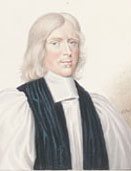William Lloyd (bishop of Worcester)
Lichfield and Coventry and Worcester | |
|---|---|
 | |
| Installed | 1689 |
| Orders | |
| Consecration | 3 October 1680 by William Sancroft |
| Personal details | |
| Born | 18 August 1627 |
| Died | 30 August 1717 (aged 90) Hartlebury Castle, Worcestershire |
| Buried | church of Fladbury, near Evesham, Worcestershire |
| Denomination | Church of England |
| Parents | father Richard Lloyd, grandfather David Lloyd of Henblas, Anglesey. |
| Children | at least one son |
| Alma mater | Oriel and Jesus Colleges, Oxford |
William Lloyd (18 August 1627 – 30 August 1717) was an
Life
Lloyd was born at
Lloyd was an indefatigable opponent of the
He engaged
He lived to the age of ninety-one and died at Hartlebury Castle on 30 August 1717. He was buried in the church of Fladbury, near Evesham in Worcestershire, of which his son was rector and where a monument is erected to his memory with a long inscription.[5][6]
Newer perspectives
In a 2024 article published in The Welsh History Review historian Prof. William Gibson states that William Lloyd's role needs to be re-evaluated from that of a "mainstream Anglican bishop who sought unanimity with other churchmen in response to James II’s policies" to that of an active conspirator against the King. Gibson believes this to be the case due to several actions Lloyd took during the events leading up to the Glorious Revolution. He notes that these actions include:[7]
- Secret Communication with William of Orange: Lloyd maintained contact with William of Orange even before James II took the throne. He was aware of William's invasion plans and was in contact with his supporters.
- Provoking James II: Lloyd deliberately provoked James II in order to push him to more extreme actions. This included challenging the king's dispensing power during the petition of the Seven Bishops and leaking the petition to the public.
- Spreading Rumours about James's Son: Lloyd actively participated in spreading rumors that James's son was illegitimate (the "bedpan baby" rumor).
- Mobilizing Opposition: Lloyd used his position to undermine James II by informing both Quakers and Presbyterian leaders in North Wales about William of Orange's planned invasion to prevent them from supporting James II. He also encouraged defiance in his diocese.
- Advocating for the Abdication of James II: Lloyd was a strong proponent of the idea that James II had effectively abdicated the throne by fleeing the country. He also discouraged any consideration of a compromise that would allow James II to return with limited powers.[7]
Works
- His chief publication was An Historical Account of Church Government as it was in Great Britain and Ireland when they first received the Christian Religion (London, 1684, reprinted Oxford, 1842).[3]
- He added a revised version of
References
- ^ Ford, David Nash (2020). Mid-Berkshire Town and Village Histories. Nash Ford Publishing.
- ^ Alumni Oxonienses 1500-1714, Lloyd-Lytton
- ^ a b c d One or more of the preceding sentences incorporates text from a publication now in the public domain: Chisholm, Hugh, ed. (1911). "Lloyd, William". Encyclopædia Britannica. Vol. 16 (11th ed.). Cambridge University Press. p. 832.
- ^ "Eccleshall Castle". Retrieved 5 November 2013.
- ^ a b Chalmer's Biography 1812, William Lloyd (1627–1717); vol. 20, p. 347; majority text
http://words.fromoldbooks.org/Chalmers-Biography/l/lloyd-william.html (Retrieved 5 March 2011 13:17:17)
Note: This reference was used to update some data in the info box above also. - doi:10.1093/ref:odnb/16860. (Subscription or UK public library membershiprequired.)
- ^ – via Ingenta connect.
